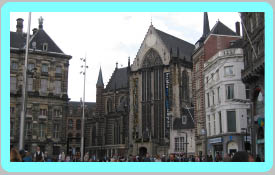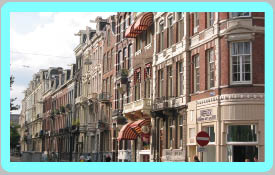
The Netherlands early history is linked with Belgium and Luxembourg; the three were known as the 'Low Countries' until the 16th century when the present-day Netherlands' boundaries were roughly drawn. Originally the land was inhabited by tribal groups: the Germanic Batavi drained the sea lagoons while the Frisii lived on mounds in the remote north.
In the late 16th century the region's northern provinces, inhabited by recent converts to Protestantism, united to fight the Catholic Spanish rulers. Philip II of Spain sent the cruel inquisition to enforce Catholicism and war broke out in 1568. The revolt of the Netherlands was led by Prince William of Orange, nicknamed William the Silent for his refusal to enter into religious arguments. After 80 years of conflict Holland and its allied provinces expelled the Spaniards in 1648 and Holland became synonymous with the independent country that emerged in this corner of Europe (a bit like saying England when you mean Britain).
 -------------
-------------
Amsterdam pranced onto the European stage in what was the province of Holland's most glorified period: the golden age from about 1580 to about 1740, after which the British began dominating the world's seas. The era's wealth was generated by the Dutch East India Company which sent ships to the Far East in search of spices and other exotic goods, while colonizing the Cape of Good Hope, Indonesia, Surinam, the Antilles and New Amsterdam (today's New York) and establishing trading posts throughout Asia.
Meanwhile Amsterdam's bourgeoisie indulged in fine, gabled canal houses and paintings of themselves and the remains of last night's dinner. This in turn stimulated the arts and brought renown to painters such as Rembrandt. But it didn't last. In 1795 the French invaded and Napoleon appointed his younger brother Louis as king. When the largely unpopular French occupation came to an end, the United Kingdom of the Netherlands - incorporating Belgium and Luxembourg was born. The first king, King William I of Orange was crowned in 1814, and the House of Orange rules to this day. In 1830 the Belgians rebelled and became independent; Luxembourg did the same soon after.
The Netherlands was able to stay neutral through WWI but couldn't exercise the same privilege in WWII. The Germans invaded in May 1940, obliterating much of Rotterdam in a bombing blitz four days later. Although a sound Dutch resistance movement formed, only a small minority of the country's substantial Jewish population survived the war. In 1949, despite military attempts to hold on to Indonesia, the colony won independence. Surinam followed with a peaceful handover of sovereignty in 1975. The Antilles, off the coast of Venezuela, are still a colony, but are largely self ruled. The Netherlands is a staunch supporter of the European Union, and further integration is taken for granted by most Dutch people.

|
The Netherlands has just one main international airport, Schiphol, about 10km south-west of Amsterdam. Although it's one of Europe's major international hubs, flights to London or Brussels are usually cheaper than flights to Amsterdam, and many travelers do the last leg to Amsterdam by train or bus. There are no departure taxes if leaving the Netherlands by air. Long distances Eurolines buses connect Amsterdam to most European cities, as well as to North Africa. Eurolines and Citysprint buses travel across the channel to Britain, usually through France (make sure you've got a visa if required). Amsterdam's Centraal Station has regular and efficient rail connections to all neighboring countries, but the bus will always be cheaper unless you've got a Eurail pass or equivalent.
|
 |
Traveling to the Netherlands by car or motorcycle on those lovely Western European highways is easy. If you're driving from the UK it's a fair bit cheaper to put your car on the ferry than hop on the shuttle through the Tunnel, though the latter might save a few hours traveling time from London. Most travelers go overland through Belgium and France to pick up a boat to England, but ferries also run between Hook of Holland and Harwich, UK; Europoort (near Rotterdam) and Hull, UK; Ijmuiden (near Amsterdam) and Newcastle, UK; and Ijmuiden and Kristiansand, Norway.

The best way to get around is by bicycle. Most places in the Netherlands are linked by dedicated cycle paths and the terrain is wonderfully flat. Bicycles are available for hire from train stations and from rental services in larger towns. If you're tempted to buy a cheap bike on the street, be aware that it's definitely hot, and that the money you hand over is probably going straight up the vendor's arm. And no matter what you're pedaling, make sure you lock it up securely to an immovable object; most locals use two locks, which are generally worth more than the bicycle itself.
The train and bus networks are reliable, comfortable and quite expensive - you can take your bike on the train. Driving within the Netherlands isn't much fun once you're off the highways: the roads are narrow and parking spaces are hard to come by and usually very expensive. Driving a vehicle with foreign number plates is an invitation to having the car broken into, especially in Amsterdam: never leave anything valuable in your car. And if you're asking a Dutch person for directions, be aware that they'll know how to get there, but only by bike - you'll have developed a healthy appreciation for this cultural idiosyncrasy by the time you face up to your ninth no entry sign.




